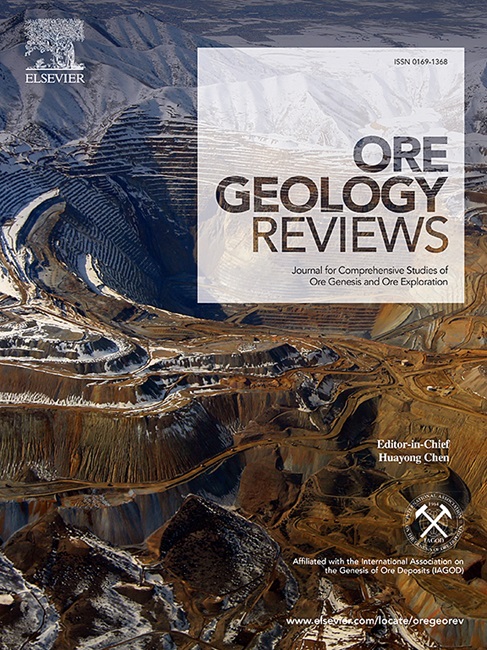锡铜矿化的关键控制因素:世界级地久锑铜多金属矿床案例研究
IF 3.6
2区 地球科学
Q1 GEOLOGY
引用次数: 0
摘要
地久是全球著名的锡铜多金属矿区,包含大量岩浆岩。地久矿区东南部的岩浆岩包括马松花岗岩、拉奥卡花岗岩、斑岩和玄武岩。以前的研究表明,该地区的锡矿化主要与等花岗岩有关,而铜矿化则主要与玄武岩有关。尽管如此,控制该地区锡-铜矿化形成和分布的主要因素仍然没有得到很好的解释。这篇论文描述了高凤山锡铜矿床和竹叶山铜锡矿床的形成机制,重点研究了母岩马松花岗岩和老冈等花岗岩的成岩过程,以及成矿岩浆热液的演化过程。通过将 Masong 和 Laoka 等粒状花岗岩和玄武岩的体岩地球化学与这两种花岗岩的生物地球化学和相关矽卡岩的黄铁矿地球化学相结合,实现了这一目标。马松和拉奥卡等花岗岩由混合地壳-幔源岩浆结晶而成。像 Masong 花岗岩这样的还原花岗岩经历了高度的分块结晶,并具有较高的卤素,具有锰矿化的前景。Zhuyeshan 矿床黄铁矿中异常高浓度的铜表明,铜主要来源于花岗岩外部。高凤山和竹叶山矽卡岩型矿石和层状矿石中的石榴石的铀-铅年龄分别为 88.2 ± 1.4 Ma 和 81.8 ± 3.7 Ma,而竹叶山矽卡岩型矿石中的蛭石的铀-铅年龄为 84.1 ± 0.5 Ma。这些年龄证实,锡矿化和铜矿化事件都发生在晚白垩世,与花岗岩侵入体的形成同时发生。值得注意的是,铜矿化与玄武岩(约 244.4 Ma)之间没有直接的地质年代联系,而玄武岩与 Laoka 等花岗岩之间有着密切的空间关系。结合之前的 S-Pb 同位素数据,我们提出地久大规模铜矿化是晚白垩世等花岗岩岩浆流体从玄武岩中提取铜的结果。本文章由计算机程序翻译,如有差异,请以英文原文为准。

The key controlling factors on Sn–Cu mineralization: A case study from the world-class Gejiu Sn–Cu-polymetallic deposit
Gejiu, a globally prominent Sn–Cu-polymetallic district, contains an extensive suite of magmatic rocks. Magmatic rocks in the southeastern portion of the Gejiu district comprise the Masong and Laoka equigranular and porphyritic granites, and basalts. Previous studies have suggested that Sn mineralization in this region is primarily associated with the equigranular granite, whereas Cu mineralization is predominantly associated with the basalts. Despite this, the major factors controlling the formation and distribution of Sn–Cu mineralization in this region remain poorly constrained. This contribution characterizes the mechanisms of formation of the Gaofengshan Sn–Cu and Zhuyeshan Cu–Sn deposits, focusing on the petrogenesis of the host Masong and Laoka equigranular granites, and the evolution of the ore-forming magmatic–hydrothermal fluids. This is accomplished by combining bulk-rock geochemistry of the Masong and Laoka equigranular granites, and basalt, with biotite geochemistry from both granites and pyrite geochemistry from associated skarns. The Masong and Laoka equigranular granites crystallized from hybrid crust–mantle-derived magmas. Reduced granites like the Masong that underwent high degrees of fractional crystallization, and have elevated halogen are prospective for Sn mineralization. The abnormally high concentrations of Cu in pyrite in the Zhuyeshan deposit suggest that the Cu was primarily derived from sources external to the granite. Garnets from skarn-type ores and stratiform ores at Gaofengshan and Zhuyeshan yielded U–Pb ages of 88.2 ± 1.4 Ma and 81.8 ± 3.7 Ma, respectively, while vesuvianite from the skarn-type ores at Zhuyeshan yield a U–Pb age of 84.1 ± 0.5 Ma. These ages confirm that both the Sn and Cu mineralizing events occurred during the Late Cretaceous, coeval with emplacement of the granitic intrusions. Notably, there is no direct geochronological link between Cu mineralization and the basalt (ca. 244.4 Ma), which has a close spatial relationship with the Laoka equigranular granite. Combined with previous S–Pb isotope data, we propose that large-scale Cu mineralization in Gejiu resulted from the extraction of Cu from basalt by fluids exsolved from the Late Cretaceous equigranular granitic magmas.
求助全文
通过发布文献求助,成功后即可免费获取论文全文。
去求助
来源期刊

Ore Geology Reviews
地学-地质学
CiteScore
6.50
自引率
27.30%
发文量
546
审稿时长
22.9 weeks
期刊介绍:
Ore Geology Reviews aims to familiarize all earth scientists with recent advances in a number of interconnected disciplines related to the study of, and search for, ore deposits. The reviews range from brief to longer contributions, but the journal preferentially publishes manuscripts that fill the niche between the commonly shorter journal articles and the comprehensive book coverages, and thus has a special appeal to many authors and readers.
 求助内容:
求助内容: 应助结果提醒方式:
应助结果提醒方式:


